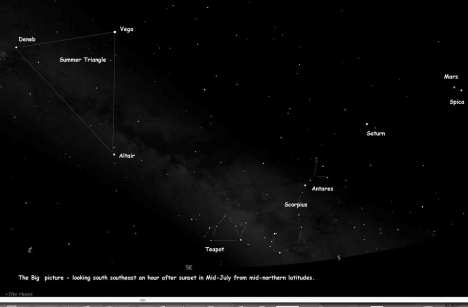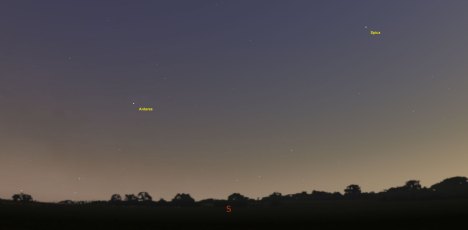We’re going to cheat a little this month and look quite a bit south of east, rather than due east. The reason is we have some wonderful stars getting as high as they get if we look that way – AND we have two bright planet and colorful planets, Saturn and Mars which make for some interesting comparisons with nearby stars. We also have a couple of really cool asterisms and even a great constellation.
I’m not a big fan of constellations. Most don’t look anything like their names imply; some are quite obscure; and many simply can’t be seen in typical suburban skies these evening because of light pollution. Scorpius is an exception. It looks like the Scorpion of its name – a truly beautiful constellation with its graceful, curving tail. What’s more, many of its brighter stars actually do hang out together – they are not just an accident of our line of sight.
It dominates our southeastern sky in July, just as the Summer Triangle – a terrific asterism, dominates our eastern sky this month. And we have two fascinating new “guide” stars – the intriguingly close and rapidly spinning Altair – and the incredibly huge and red Antares that is right at the heart of the Scorpion!
Antares begs comparison with Mars – both being red. But Mars is also very, very close to a bright blue star, Spica. Mars will be just a bit brighter than either of these comparison stars. Saturn – between Mars and Antares and also very bright, has a yellowish hue.
But the real treat at this time of year remain these southern stars. They never get real high and from mid-nothern latitudes we only get a couple hours on a summer night when they are really well in view above the southern horizon. To top it all off the Milky Way runs from Deneb in the Summer Triangle to the tail of Scorpius,but you have to wait a couple hours after sunset before this comes out.
Let’s take a look at the chart, then examine Scorpius along with its quaint little companion, a very real looking teapot complete with “steam” coming out of its spout! Wow! Summer nights may be short, but they sure offer some nice visual treats!

Click to enlarge! This chart covers a bigger section of sky then we usually show. Vega, for example, will be six fists up. Oh – about that “teapot.” We won’t discuss it, but you can clearly see it tagging behind the scorpion. If you have real clear skies, the Milky Way is beautiful in this area and looks like steam rising from the teapot. More on this next month. (Developed from a Starry Nights Pro screen shot. )
First up is the Summer Triangle – it’s an asterism that you can’t miss, and it will grace our evening skies right up into early winter. If you’ve been following for a few months, you’ve already met its lead star, brilliant Vega. And last month we were introduced to Deneb on the other corner. In fact, we saw that we could make a quite impressive Northern Triangle out of Deneb, Vega, and Polaris. But far better known than that asterism is the Summer Triangle shown above of Vega, Deneb, and Altair.
Altair is hard to miss. It is the brightest star low in the east early on a July evening, but it is also distinctive because it has two reasonably bright companions, close on either side, that form a straight line with it. This is appropriate because it’s not hard to see Altair and those two companions as representing an eagle in flight, and that’s good because they are the major stars in a constellation known as Aquilla, the Eagle.
Altair is white, much like Deneb and Vega, and is even closer to us than Vega. Vega is 25 light years away, Altair just 16. That’s in contrast to Deneb, which you may recall is an astounding 1,425 light years (at least) from us – astounding because even at that distance it is almost as bright as its much closer companions and some experts believe it is much more distant.
Altair also distinguishes itself by spinning incredibly fast. It takes our Sun almost a month to complete a rotation on its axis. Altair, almost twice as large as our Sun, spins once on its axis in just 10 hours. Why, I don’t know, but it’s one more reminder of how these stars, which all look pretty much the same to us because they’re so far away, all have their special traits that distinguish them as individuals.
The most obvious special trait for Antares, our other new guide star this month, is its redness – and it’s one of only four guide stars that is quite close to the ecliptic – the path of the planets. That means that reddish Mars comes close, sometimes, to reddish Antares, and that’s appropriate because the name “Antares” actually means “like Mars.” However, science tells us something else about Antares. It is huge. I mean BIG.
Get out your calculator and do a little simple math. (OK, I’ll do the math, but really – this is simple, and I think you would appreciate the numbers much more if you did the calculations yourself.) One possible source of confusion: To visualize a sphere I use its diameter. To actually calculate things I need the radius – since a radius is half of a diameter you’ll find me jumping back and forth between these two terms – don’t let it confuse you.)
So try this. Start with something manageable, like the Earth. It’s about 8,000 miles in diameter and that’s a number that’s fairly easy to imagine. Let’s reduce Earth to a ball 2 inches in diameter. It would have a radius, then, of one inch.
Now let’s make a scale model Sun to go with our Earth. That’s easy. The radius of the Sun is 109 times the radius of the Earth. That means the Sun will have a radius of 109 inches – roughly 9 feet. So now we have a one-inch Earth and a 9-foot Sun. So our scale model has two balls – one two inches in diameter to represent the Earth and one 18 feet in diameter to represent the Sun.
That certainly should tell you that the Sun is a lot bigger than Earth, but my problem is, these linear measures don’t give us a really good sense of the size difference. We need to visualize spheres in terms of volume. We can get a rough approximation of the volume of a sphere by simply cubing the radius and multiplying it by 4. If we do this for our scale model Earth we have (1 x 1 x 1) x 4 – or four cubic inches. Now to calculate the volume of our scale model Sun – in cubic inches – we multiply 109 x 109 x 109, then multiply that by 4. Wow! Well, if you tried it on your calculator I hope you said “Wow!” You should get 5,180,116. That means you can fit well over one million Earths in our Sun! That to me is a lot more impressive than the linear measure where we find the diameter of the Sun is about 109 times the diameter of Earth.
Now let’s do a similar exercise with Antares. Antares has a radius more than 800 times the Sun. Do the math. Our scale model Sun has a radius of 9 feet – our scale model Antares will have a radius in feet of 9 x 800. Man, that’s big. About 7,200 feet! (Just remind yourself that a mile is 5,280-feet.) So now we have three models – a 2-inch diameter Earth, an 18-foot diameter Sun, and a 14,400-foot diameter Antares – that last is approaching three miles!
Don’t bother to calculate the volume. Unless you use scientific notation, your calculator probably won’t handle it. But you get the idea. That little dot of red light we call Antares is B-I-G. And don’t forget – on this same scale the huge planet you are standing on is just 2-inches in diameter.
Here’s a graphic representation courtesy of Sakurambo:
Notice the artist didn’t even attempt to represent the Earth on this scale!
Think of it this way. If Antares were our star, both the Earth and Mars would be orbiting inside it!
That’s huge – even bigger than Deneb – which we noted last month was a “supergiant” – the same class that Antares belongs in. But Deneb would only reach about halfway to Earth – Antares would go past both Earth and Mars. Deneb, however, is a very young, very bright, very hot star, which is why it shines so brightly from such a great distance. Antares is much closer – about 600 light years vs at least 1,425 for Deneb. But Antares is old – a star in its dying stages, and is large and bright because it is so bloated. It really is quite cool as stars go – that’s why it appears red to us. But it has such a huge surface area that even from a distance of 600 light years it appears bright to us – a bit brighter in our sky than Deneb, actually.
So let’s briefly consider these four guide stars together – Vega is our “standard” star – white, about the size of the Sun, and quite close at 25 light years. Altair has some unusual features, but is still rather normal as stars go. Deneb is distinguished by being large and hot; Antares by being even larger, but relatively cool.
Vital stats for Altair (AL-tair), also known as Alpha Aquilae:
• Brilliance: Magnitude .77; its luminosity is the equal of 11 Suns.
• Distance:16.8 light years
• Spectral Types: A, main sequence
• Position: 19h:50m:47s, +08°:52′:06″
Vital stats for Antares (an-TAIR-ease), also known as Alpha Scorpii:
• Brilliance: Magnitude 1.09; its luminosity is the equal of 65,000 Suns.
• Distance: 600 light years
• Spectral Types: M, supergiant
• Position: 16h:29m:24s, -26°:25′:55″
Filed under: Uncategorized | Tagged: Altair, Antares, Mars, Milky Way, Saturn, Spica, starc olor, Teapot | Leave a comment »

















